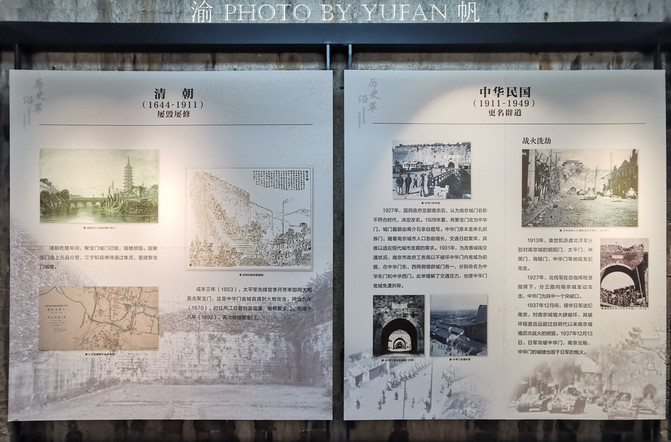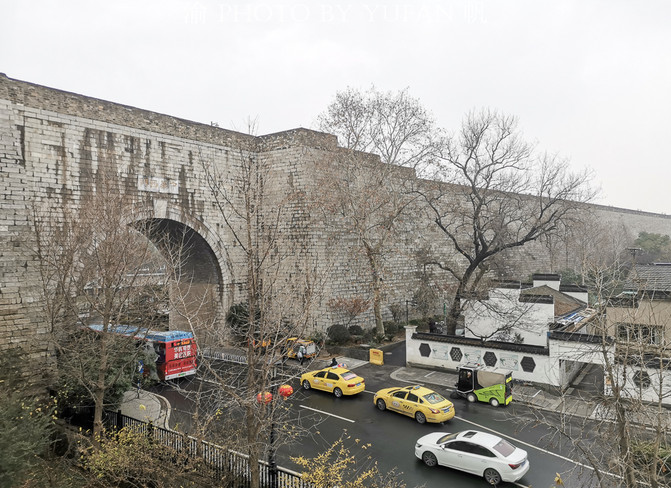The largest existing city gate in China has a history of more than 600 years, and every plot of bricks is extraordinary.

Our country is an ancient civilization with a long history. There are many ancient cities, ancient capitals, and ancient towns. Among these ancient cities, many ancient city walls and gates are still preserved, especially in famous ancient capitals such as Beijing and Xi'an. But if you want to ask which is the largest existing gate in China? It is estimated that many people cannot answer the question. It is not in Beijing or in the southwest, but in Nanjing, Jiangsu, and is the Zhonghua Gate on the wall of the Ming Dynasty.

Zhonghua Gate, formerly known as Jubao Gate, was one of the thirteen gates of the Ming Dynasty capital on the Ming City Wall in Nanjing (The thirteen city gates include: Zhengyang Gate, Tongji Gate, Jubao Gate, Yifeng Gate, Zhongfu Gate, Jinchuan Gate, Shence Gate, Dinghuai Gate, Taipingmen, Chaoyang Gate, Sanshanmen, Shicheng Gate, Qingliang Gate), it is the largest existing city gate in my country, an outstanding representative of ancient Chinese defensive buildings, and also the most well-preserved and complex fortress Wengcheng in the world. It is known as the "World's No. 1 Wengcheng".

The Zhonghua Gate has a strict layout and unique structure. It is an important physical material for studying ancient Chinese military facilities. It occupies an important position in military, historical, cultural and urban construction history.

Zhonghua Gate was once the south gate of Jiangning Prefecture, the capital of the Southern Tang Dynasty, and Jiankang Prefecture, the capital of the Southern Song Dynasty. It was expanded from the second to eighth years of Hongwu of the Ming Dynasty (1369 to 1375) and was called Jubao Gate. In 1931 (20th year of the Republic of China), the National Government changed its name to Zhonghua Gate. Chiang Kai-shek inscribed a plaque on the eve of the Double Tenth Festival, and opened Zhonghua East Gate and Zhonghua West Gate on the east and west sides respectively to accommodate two-way vehicle traffic from the north to the south.

The ancient Zhonghua Gate is equipped with three barns and four ticket gates, in a "eye"-shaped structure. Each barns has one gate and one gate. The barns in the main building are composed of the main gate of the Zhonghua Gate and two to four auxiliary gates. Each gate has two iron doors and a thousand-jin gate that can be activated up and down. There are bolt grooves in it for wooden bolts to close the gate. There are 27 soldiers hiding holes in the entire city, which can hide more than 3,000 soldiers.

Now Zhonghua Gate has been listed as a national key cultural relic protection unit and an important part of the national AAAAA tourist attraction-Confucius Temple Qinhuai River Scenic Belt. It is also included in the list of participants in China's world cultural heritage (China Ming and Qing Dynasties City Wall Project).

There are two floors of Zhonghua Gate, but the tower hall above the third floor no longer exists. The Zangbing Cave on the second floor is used as a historical and cultural exhibition hall, a center for listing cultural and creative products on the city wall. In the Zhonghua Gate Historical Exhibition Hall, you can understand the history of Nanjing's Ming City Wall and Zhonghua Gate with pictures and texts.

For example, the poems, songs, and poems written by historical literati and literati when they climbed the Zhonghua Gate. Among them, the more famous one is "Chang Gan Xing" by the poet immortal Li Bai: a concubine's hair begins to cover her forehead, and a drama is folded in front of the door. Lang rode a bamboo horse and walked around the bed to make green plum blossoms. Living together in Changganli, my two children have no qualms about guessing, and I am the daughter-in-law at fourteen, and I have never been ashamed. Bow your head towards the dark wall, calling you back for a thousand times. At the beginning of the fifteenth day, I spread my eyebrows, wishing to share the dust and ashes. Always hold the pillar and letter, how can you look forward to your husband's platform? The sixteen gentlemen traveled far away, and the ponds were piled up... The Changganli in the poem refers to today's Nanjing City.

According to data, the construction of Zhonghua Gate and Nanjing Ming City Wall took a total of 21 years. The entire building was made of a mixture of lime, tung oil and glutinous rice juice as a binder and made of huge bricks. It is extremely strong. The city wall is laid with strip-shaped granite. Each brick is about 40-50 centimeters long and each weighs 15-20 kilograms. The firing technology is extremely difficult and can be said to be specially customized. The manufacturer and supervisor are also engraved on it. The name of the person to ensure the quality of the city bricks and the strict inspection pass rate.

In the ancient era of cold weapons, the city wall was the most important defense of the country. The strength of the city wall not only reflects the majesty of the royal power, but is also directly related to the safety of the country. Therefore, when building the city wall, the highest decision-makers of successive dynasties always regarded the quality of the project as the top priority and did not dare to slack off.

However, the vicissitudes of life have changed, and most of the once-majestic city walls in China have failed to withstand the test of time and were eventually annihilated by artillery fire or wind and rain. Among the city walls in ancient China, the Nanjing Ming City Wall personally supervised by Zhu Yuanzhang was not only the longest city wall in the world at that time, but also one of the strongest city walls in the world to date. It has survived more than 600 years of ups and downs, and it is still as solid today.

According to the staff, the military defense function of the Nanjing Ming City Wall was aimed at the siege equipment and firearms at that time, and at the same time combined with the terrain and landform of the Nanjing area. Whether it was the height, thickness, foundation, building materials, and key parts of the city wall. Fortification, as well as its city defense building system, have reached the level of perfection in China's city wall architecture.


The most important reason why Nanjing's city wall and Zhonghua Gate have stood tall for more than 600 years is that every brick used can be well traced back. Each brick is responsible for nine people from top to bottom, so every brick has excellent quality guarantee.

It is reported that Zhu Yuanzhang, the Emperor of the Ming Dynasty, listened to the advice of his adviser Zhu Sheng to "accumulate grain extensively and build high walls", but was worried that the officials who forged the wall bricks would cut corners, so he ordered the name of the maker to be written on each brick. This quality tracking system is probably the first implemented by Zhu Yuanzhang, the Emperor of the Ming Dynasty, worldwide.

In the early years of the Ming Dynasty, no one wanted to lose their heads, and the person serving was such an emperor who enjoyed killing people. Therefore, each brick not only withstands the test of the supervisors at that time, but also withstands the test of time. More than 600 years have passed, and the words on each brick are clearly visible.

At that time, the most basic test standard for city bricks was to "knock them with a sound, but break them without holes." The implication was that they must make a clear sound when knocked and even be used as a musical instrument. After knocking them off, No air holes should appear in the middle of the brick.

In order to introduce the city bricks of these city walls, there is a special city brick exhibition in a Tibetan soldier cave on the second floor of Zhonghua Gate, which introduces in great detail the firing process and traceability system of these city bricks, as well as the firing of city bricks across the country. Differences, etc.

It can be seen from the pictures and texts displayed that the production process of these city bricks is very standardized. Just like today's standardized operations in the manufacturing industry, each process has clear regulations and cannot be lazy at all.

In order to build the Ming City Wall, the longest and largest ancient city wall in the world, Zhu Yuanzhang used a total of 280,000 migrant workers in 152 prefectures and counties across the country, 3 Wei, 5 provinces, 37 prefectures and counties, and used about 350 million city bricks. It lasted for 28 years, and finally completed the pattern of the four walls of Yingtian Palace in the capital.

As can be seen from the above picture, in order to ensure the quality of these city bricks, clear words are printed on each brick, and these words must include nine responsible persons including brick makers, kilns, small armor, chief clerk, secretary officials, general judgment, and adjudicator. If it is concluded that the city bricks are unqualified, then all nine people on the bricks will be held accountable, and in serious cases, they will even be sentenced to death.

This is the type of bricks. There were generally three types of bricks in the Ming Dynasty. One was military bricks (such as Jinwuwei, Feixiong Wei, Guangyang Qiansuo, etc.), the other was the Ministry of Industry (such as the Ministry of Industry Guanfang, Guanqian Kiln, etc.), and the other was temple bricks (such as Dahe Temple, Baoen Temple, etc.).

Surprisingly, some modern simplified characters, such as "Wan" and "Liu", were also found on these city bricks. This is really a bit difficult to understand. Could it be that when simplifying Chinese characters back then, they referred to these city bricks?

Another unexpected thing was that the RMB had the wrong version, and this city brick actually had the wrong version. Moreover, a person with the same name as Liu Tianwang was found on this city brick.

Before the 1980s, Zhonghuamen Castle was in an abandoned state all year round. After it was officially opened in 1980, under the leadership and planning of the National Tourism Administration, the Landscape Administration, the Qinhuai District Government, and the Nanjing City Cultural Management Association, it was renovated and improved. The Zhonghua Gate Historical Materials Exhibition Room and Bonsai Garden were established successively, and the relocation and cleaning of surrounding residents, factories and businesses were completed, and the environment was comprehensively upgraded.

In 1995, Zhonghua Road and Yuhua Road were renovated, and Zhonghua Gate Square was built around Zhonghua Gate Castle. The castle and the square were connected into one, setting off each other and making them even more majestic and majestic. Nearly 10,000 square meters of green area have been added, and a number of high-pole lighting palace lanterns and lawn lights have been installed. The environment is very beautiful and transportation is more convenient. At present, except for the enemy buildings and Jiaoguan pavilions, the original appearance of the ancient castle has been basically restored. Now it is not only a national key cultural relic, but also included in the World Cultural Heritage Preparatory List.
Previous Article:Nanjing, Jiangsu Province, walking around Zijin Mountain
Next Article:Nanjing people look at Nanjing-Autumn Stone Elephant Road
